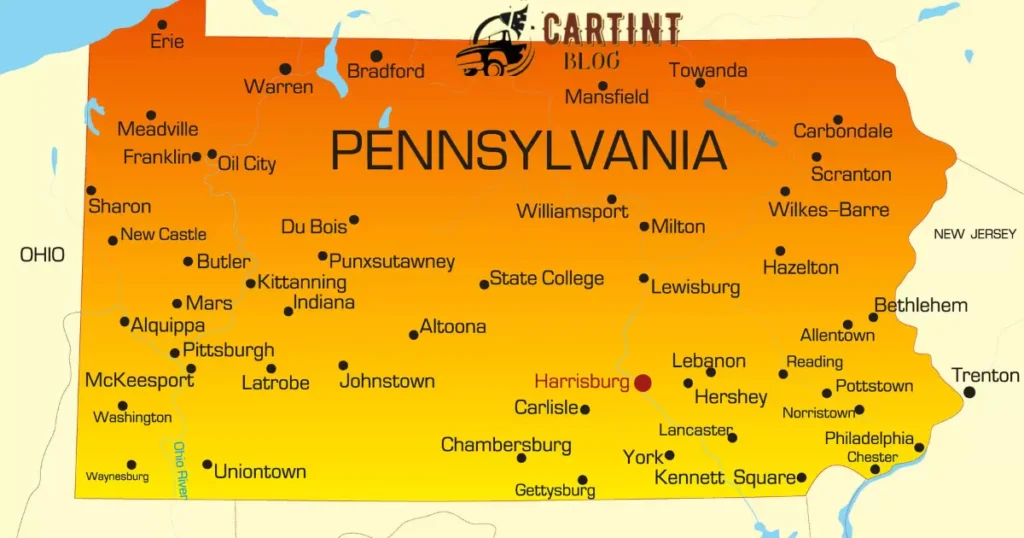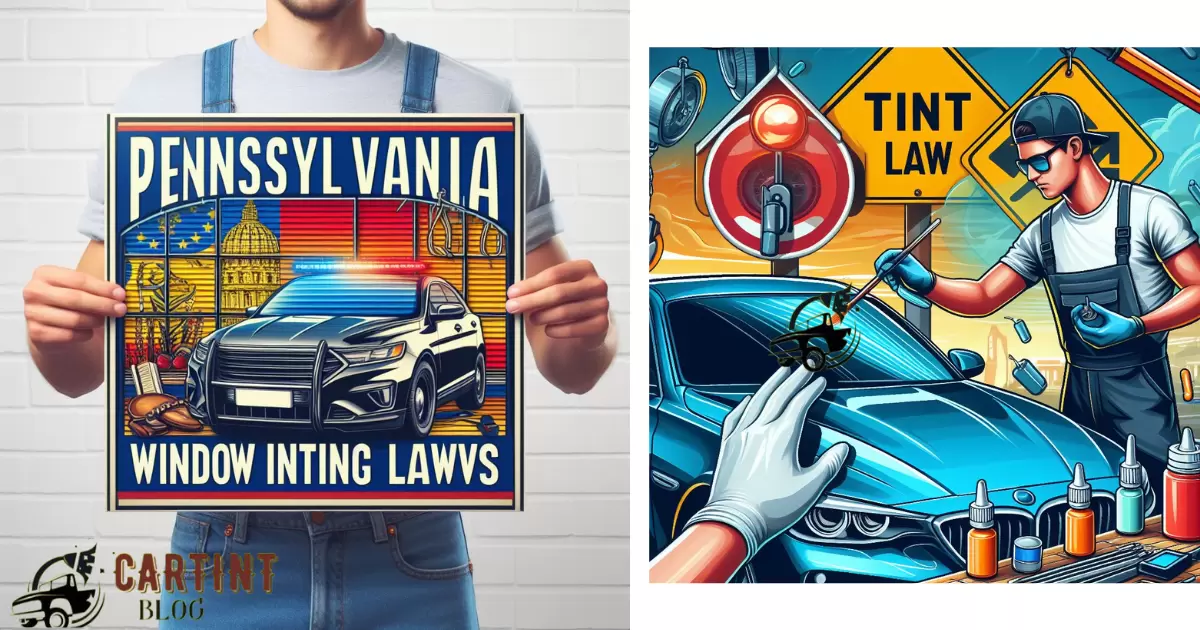Pennsylvania Window Tinting Laws refer to regulations governing the darkness of window tint on vehicles in the state. These laws are established to ensure safety on the roads and maintain visibility for drivers and law enforcement.
Curious about how Pennsylvania Window Tinting Laws can impact your driving experience? Navigating these regulations is crucial, as they not only influence the aesthetics of your vehicle but also play a key role in maintaining road safety.
In Pennsylvania, the laws dictate specific limits on the darkness of window tint, measured as Visible Light Transmission (VLT). For instance, front side windows must allow at least 70% VLT, while rear windows can have a lower VLT, but not less than 20%.
Darkest Legal Tint in Pennsylvania
Windshield
Must let in over 70% of the light, with no more than 3 inches of darkness above.
Windows on the front side
They must let in more than 70% of the light.
Backside windows
You can use any level of darkness.
Rear window
You can use any level of darkness.
Darkest Legal Tint For Cars
- In Pennsylvania, the darkest legal tint for cars is 20% for sedan and SUV rear windows.
- The front side windows must allow at least 70% of light to pass through, ensuring proper visibility for drivers.
- These regulations aim to enhance road safety by maintaining adequate visibility for law enforcement and promoting driver awareness.
Points to Note
- Front Side Windows Must allow at least 70% of light to pass through.
- Safety Focus Regulations contribute to road safety and visibility for law enforcement.
Darkest Legal Tint For Suvs And Vans
SUVs and vans More than 70% of light must pass through the front side windows. You can tint the front side, back side, and rear window to any degree of darkness. Additionally, the windshield must let in 70% of the light, except the top three inches.
Sedans More than 70% of the light in the car must be able to pass through the front, rear, and side windows. With the exception of the top three inches, the windshield must likewise let in more than 70% of the available light.
Windshield Tint Rules In Pennsylvania
Apply a 70% window tint to the front windows and windshield; the rear seat and rear windows are exempt from this requirement. In Pennsylvania, a 5% tint is not permitted on passenger cars.
Nonetheless, there are a few exceptions for cars with multiple uses. Your adaptable vehicles’ back and rear window tints can be applied at a percentage of 5%.
Mpv Window Tint Laws In Pennsylvania

Pennsylvania’s tint laws for MPVs (referring to multi-purpose vehicles such as sport utility vehicles, trucks, passenger vans, motor coaches, etc.) with driver and shotgun seats can have a 70% lighter VLT on the front side windows.
Any Window tints are also allowed in the dark, including full privacy blackout tints, on the rear side windows and on the rear windshield of the vehicle. As with car window film in Pennsylvania, the tint may not be metallic or reflective in appearance for larger vehicles.
Other Window Tint Rules In Pennsylvania
Discover windshield tint costs! Wondering, Should You Wash Your Car Before Tinting Windows? Professional tinting ranges $100-$1000. Stay legal, check local laws.
Pennsylvania’s window tint regulations for sedans state that by 2024, the front windshield must have more than 70% visible light transmission, with the top 3 inches of blackness permitted.
Up to 70% VLT is permitted for front side windows, while up to 70% VLT is permitted for rear windshields with dual side mirrors.
Window Tint Violations In Pennsylvania
In Pennsylvania, car window tint violations are strictly regulated. The law stipulates that front side windows must allow more than 70% of light, while the rear side and rear windows can have any darkness. Windshield tint is permitted only above the manufacturer’s AS-1 line.
As of 2023, fines for window tint violations in Pennsylvania range from $25 to $50 for the first offense, and subsequent offenses can result in fines up to $75. It’s crucial for drivers to comply with these regulations to avoid penalties and ensure road safety.
Medical Conditions Qualifying For Window Tint In Pa
To obtain medical authorization for window tint on your car, you need a written prescription from a licensed medical professional.
This prescription should clearly state the medical necessity for window tint due to a specific health condition.
Once you have the prescription, contact your local Department of Motor Vehicles (DMV) for guidance on the required documentation and procedures for obtaining approval for tinted windows on your vehicle.
State Of Pennsylvania Info

Pennsylvania, a state in the northeastern United States, boasts a rich history and diverse geography. With a population of over 12.8 million people, it stands as the 5th most populous state in the nation.
The capital, Harrisburg, serves as a central hub for government activities.
Economically, Pennsylvania contributes significantly to the country’s GDP. In 2023, its gross domestic product exceeded $800 billion, driven by a robust industrial sector, including manufacturing and energy production.
The state’s strategic location and transportation infrastructure further enhance its economic importance. Overall, Pennsylvania stands as a pivotal state in the U.S., blending historical significance with a thriving modern economy.
Pa Window Tint Law Title 75
Title 75 of the Pennsylvania Code sheds light on the regulations governing window tinting for vehicles in the state. This law stipulates that the front side windows must allow at least 70% of light to pass through, promoting visibility and road safety.
Compliance with Pa Window Tint Law Title 75 is essential for drivers to avoid fines and ensure a clear, lawful driving experience. Pa Window Tint Law Title 75 extends its reach to rear side windows and the rear window, permitting tinting as long as it does not reduce light transmission below 70%.
Is 5% Tint Legal In Pa
In Pennsylvania, a 5% tint, which significantly reduces light transmission, is not legal for vehicle windows. The state mandates that front side windows must allow at least 70% of light to pass through, ensuring visibility for drivers and enhancing road safety. Straying from this requirement could lead to penalties and fines.
It’s crucial for vehicle owners in Pennsylvania to be aware of the regulations concerning window tint percentages. Choosing a 5% tint, which is darker than the legal limit, not only jeopardizes compliance with the law but also poses risks on the road.
Staying informed about and adhering to Pennsylvania’s window tinting laws is essential for a trouble-free and lawful driving experience.
Is 15 Percent Tint Legal In Pa
In Pennsylvania, having a 15 percent tint on car windows is not legally permissible. The state’s window tinting laws mandate that front side windows must allow at least 70 percent of light to pass through, making a 15 percent tint far below the legal limit.
Violating these regulations can lead to fines and penalties, emphasizing the importance of adhering to the established guidelines for transparency on vehicle windows in the state.Ensuring compliance with Pennsylvania’s window tinting laws is essential for both safety and legal reasons.
The 70 percent light transmission requirement for front side windows aims to maintain visibility, contributing to road safety. Vehicle owners should be aware of these regulations to avoid legal consequences and promote a secure driving environment on Pennsylvania roads.
Is 20% Tint Legal In Pa
In Pennsylvania, a 20% window tint may not be legal for your vehicle. The state mandates that front side windows must allow at least 70% of light to pass through. If your tint falls below this threshold, it could lead to fines and penalties.
Ensure compliance with the law by opting for window tints that meet Pennsylvania’s regulations.When considering window tint percentages in Pennsylvania, it’s crucial to prioritize safety and adherence to the law.
With a minimum requirement of 70% light transmission for front side windows, choosing a tint that complies with this standard ensures both legal compliance and visibility on the road. Make informed decisions to enjoy a trouble-free driving experience in the Keystone State.
Is 35% Tint Legal In Pa
In Pennsylvania, a 35% tint on car windows is not legal. The state’s regulations stipulate that the front side windows must allow at least 70% of light to pass through.
This means that a 35% tint, allowing only 65% light transmission, falls short of compliance with Pennsylvania Window Tinting Laws. To ensure conformity and avoid potential fines, it’s crucial for vehicle owners to be aware of these regulations.
Choosing a window tint that meets the minimum light transmission requirements for front side windows, such as 70%, is necessary to stay within the legal limits in Pennsylvania.
70 Window Tint
Upgrade your ride with 70 window tint, providing a sleek look while maintaining optimal visibility. This tint allows 70% of light to pass through, striking the perfect balance between style and functionality.
Enhance your driving experience with this moderate tint that adds a touch of sophistication to your vehicle. Experience the benefits of 70 window tint, compliant with regulations in many states, including Pennsylvania.
Enjoy improved privacy, reduced glare, and protection from harmful UV rays. Elevate both the aesthetics and comfort of your car with this practical and stylish window tint solution.
Pennsylvania Auto Glass Tinting Dos And Don’ts
| Aspect | Dos | Don’ts |
| Tint Darkness Limits | Adhere to the state-mandated darkness limits. | Exceed the permissible darkness limits for tinting. |
| Windshield Tinting | Tint only the top portion above the AS-1 line. | Tint the entire windshield below the AS-1 line. |
| Front Side Windows | Tint within the allowed percentage for front side windows. | Exceed the maximum allowable tint percentage on front side windows. |
| Back Side Windows | Apply tint as per the state regulations for rear side windows. | Go beyond the specified tint limits for back side windows. |
| Rear Window Tinting | Follow the state guidelines for tinting the rear window. | Exceed the permissible tint darkness on the rear window. |
| Reflectivity Limits | Comply with the maximum reflectivity allowed by the state. | Use a highly reflective tint that surpasses state regulations. |
| Medical Exemptions | Obtain a valid medical exemption if applicable. | Use tinting without a legitimate medical exemption. |
| Inspection Compliance | Ensure the tinting meets inspection standards. | Ignore or neglect the inspection requirements for tinted windows. |
Understanding Pa’s Window Tint Rules
- Overview
Gain insights into Pennsylvania’s window tint regulations to navigate the legal landscape effectively.
- Transparency Standards
Understand the specified levels of transparency required for different vehicle windows, ensuring compliance with state laws.
- Safety and Visibility
Explore how these rules balance the need for sun protection with maintaining optimal visibility for safe driving.
- Legal Compliance
Learn about the importance of adhering to Pa’s window tint rules to avoid penalties and ensure a trouble-free driving experience.
- Practical Guidance
Receive practical guidance on selecting window tints that meet both legal requirements and personal preferences.
FAQs
What is the darkest legal tint in PA?
In Pennsylvania, the legal limit for window tint on sedans and SUVs is 70% for the front side windows and any darkness for rear windows.
Can I have 35% tint in PA?
No, the allowable tint percentage for front side windows in Pennsylvania is 70%. Tint percentages below this limit are not compliant.
Can you fail PA inspection for tint?
Yes, if your window tint violates Pennsylvania’s regulations, your vehicle may fail inspection. It’s important to adhere to the state’s tinting laws.
Does PA have a tint waiver?
Pennsylvania does not offer a general tint waiver. However, individuals with specific medical conditions may be eligible for an exemption with proper documentation.
What medical conditions qualify for window tint in PA?
Medical conditions such as porphyria, lupus, and xeroderma pigmentosum may qualify for a window tint exemption in Pennsylvania, provided the necessary documentation is provided.
Conclusion
In wrapping up the details on Pennsylvania car tint laws, it’s crucial for residents to abide by the state’s regulations to avoid legal complications. Remember, the permitted tint levels vary for different windows, with front side windows requiring a higher transparency than rear windows.
Striking the right balance between personal preferences and adherence to the law ensures a smooth driving experience within the legal boundaries. Stay informed about any updates to the tint laws, as they may evolve over time.
Keeping your vehicle’s window tint in compliance not only helps you avoid potential fines but also contributes to road safety and the overall well-being of the driving community in Pennsylvania. Stay aware, drive responsibly, and enjoy the benefits of clear visibility while cruising the roads of the Keystone State.



